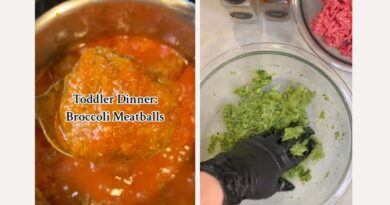Actually, please *do* let your kids play with their food
We’ve all been there: You’ve just spent a good 30 minutes creating a meal you think your kiddo will love and devour. But when you set it on the table, your child turns up their nose, declaring they won’t eat it, have never liked it, will definitely not be trying it tonight. The dinner table soon devolves into a power struggle, and you’re both left feeling upset and unheard.
As it turns out, begging your child to “just try one bite” is doing more harm than good. Instead, practice taking the pressure off. Recent research shows that letting your kid play with their food—with zero pressure to actually eat it—can help them safely explore new tastes and textures in an anxiety-free environment. Kids learn through play, and bringing that concept to mealtime can be a game-changer for many kids, but especially for kids with sensory challenges or certain food or texture aversions.
Eating is work, too
According to Simone Emery, a pediatric nutritionist and natural nutrition advocate with Little Bellies, eating is one of the most complex things a child learns. “To execute one swallow, we use 26 muscles and six cranial nerves, along with all five senses and body awareness to interpret a super-highway of information,” she notes. “Eating is a lot of hard work, so it is easy to see how a playful approach can facilitate stress-free habits.”
Bringing play into the picture at snack time and mealtime can help kids get familiar with foods—especially new foods. Letting kids play with food can also decrease anxiety and remove the sense of pressure to eat that children may feel, because it empowers their curiosity, Emery tells Motherly. “Food is less surprising when we play with it first,” she shares.
Recent research supports this. In a study of 62 preschoolers in the UK, researchers divided children into three groups: one group engaged in a sensory play activity that featured edible fruits and vegetables, one group engaged in a non-food sensory activity and the other group looked at pictures of fruits and vegetables. The researchers found that the kids who actually played with the fruits and vegetables ended up tasting and eating more than the kids in the other two groups.
“To learn about food, you need to get messy,” says Emery.
Avoiding the power struggle
So how can you ensure that a) your kid won’t starve and b) you’re not spending minutes you don’t have making a second meal? Fill their plates with a few foods your child recognizes and already enjoys, plus the addition of just one or two new foods to explore. Then, encourage them to get their hands dirty.
Letting kids touch and handle what’s on their plate with no expectation to actually taste it can depressurize the situation for all involved.
“To learn about food, you need to get messy,” says Emery. That might mean allowing kids the freedom to stack, roll, squash or mash what’s on their plate, all with the aim of just getting comfortable with the idea of a new food and its texture, scent and color. This is especially helpful when introducing foods they haven’t seen before. But allowing kids the space and time to explore here is key, Emery notes.
Ideally, this food exploration will happen during meal prep and mealtimes, in what Emery calls “play with a contextual learning purpose.”
And if they happen to taste the food while playing with it? That’s simply an added bonus.
One more thing: Try not to wipe that cute chin or clean those messy hands until exploratory time is over, Emery adds. In doing so, you’re unwittingly creating a more stressful mealtime dynamic. “Giving the child the opportunity to play, learn and eat whilst you eat alongside them is less stressful, encourages learning and sets up a long term happy relationship with food,” Emery says.
blogherads.adq.push(function(){
blogherads.defineSlot(‘flexrec’, ‘ad_div_in_body_2’).setTargeting(‘targetingKey’,
‘targetingValue’).display();
});
While yes, table manners are a very valuable skill, those can come in due course. In the meantime, opening your kid up to the wide world of food, and all the sensory experiences that come with it—is incredibly important, especially when they’re young.
Learn more about picky eaters on The Motherly Podcast
Parent and child feeding roles
“As parents, we need to make sure a child eats correctly through integrating development, nutrition and environmental cues,” says Emery. But kids should have agency in this area, too.
According to the work of nutritionist and therapist Ellyn Satter, there’s a clear demarcation between the child’s role and the parent’s role when it comes to feeding and eating. Respecting these natural boundaries can make mealtimes easier and more joyous for all involved.
The division of responsibility in feeding for toddlers through adolescents
The Ellyn Satter Institute views these roles as follows:
- The parent or caregiver decides what, when and where to eat
- The child decides whether and how much to eat
Adopting this approach is a helpful reminder that children need to be able to determine for themselves whether they want to eat in the first place—and how much of a food they want to eat.
Making food fun again
Here are a few fun ways to engage your child in play-based food exploration from Little Bellies. Try out these games at your next snack break or mealtime.
Sources
Coulthard H, Sealy A. Play with your food! Sensory play is associated with tasting of fruits and vegetables in preschool children. Appetite. 2017 Jun 1;113:84-90.
blogherads.adq.push(function(){
blogherads.defineSlot(‘flexrec’, ‘ad_div_in_body_1’).setTargeting(‘targetingKey’,
‘targetingValue’).display();
});


